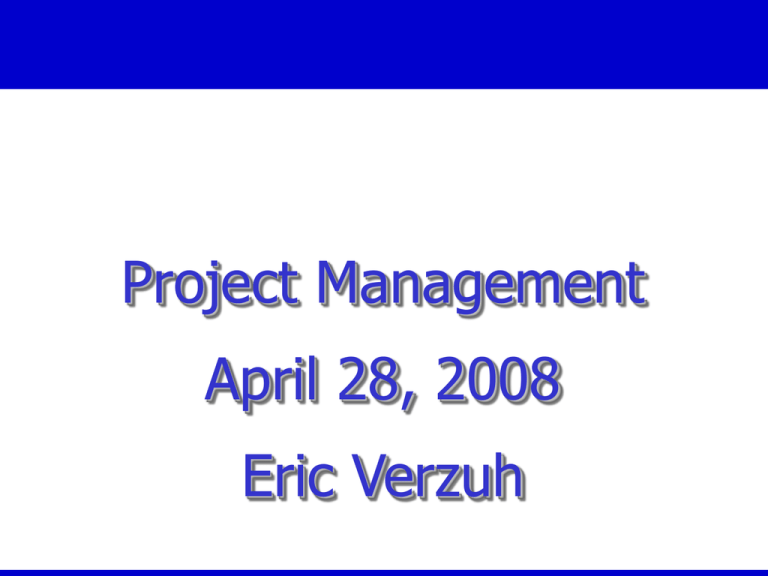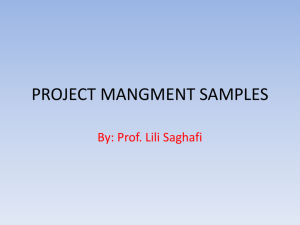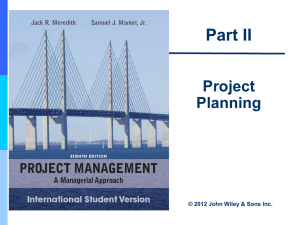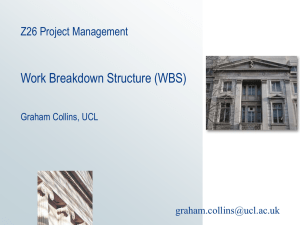
Project Management
April 28, 2008
Eric Verzuh
PROJECT LEADERSHIP
DEFINITION
PLANNING
CONTROL
Feedback, Changes & Corrective Action
Project Manager clearly assigned
Know the stakeholders
Communication Plan & RACI
Define the goals and constraints
Statement of Work and Charter
Proposals vs. Project Mgt
Proposal – what will
be accomplished.
Full lifecycle focus
Final results
Stakeholders are
widely defined
Project Plan – how it
will be accomplished.
Focus on the change
activities.
Project ends before
results are achieved.
Primary stakeholders
are actively involved
in creating change.
Identify Stakeholders!
Project
Manager
Management
Who cares?
Define
Plan
Control
Policies
Resources
What do they
care about?
Skills
Effort
Project
Authority
Guidance
Priorities
Sponsor
Requirements
Funding
Product
Customer
Project
Team
How do I
find them?
Identify Stakeholders!
Secondary
• Affected by the project
• Could become a primary if requirements
are not met
Primary
• Actively involved
• Allies
• Opponents
Stakeholder Analysis Form
Fast Foundation in Project Management
Worksheets provide a basis for
consistency
Twenty downloadable forms
Use and modify them
www.versatilecompany.com/forms
Project Workshop
15 minutes
Name your stakeholders
Be specific when
possible
Responsibility Matrix (RACI)
E – Responsible for driving execution
A – Final approval for decisions
C – Must be consulted
I – Must be informed
Plan Communication
Who needs information?
What information do they need?
When do they need it?
How will you get it to them?
How will you know they received it?
Projects do not fail from over communication!
Statement of Work
Minimum Content
Purpose
Scope Statement
Deliverables
Objectives
Cost & Schedule
Estimates
Organization
Structure
Monitoring &
Control Processes
Risks
Project Specific
Issues
Terminology Check: Charter or SOW or Scope Statement?
PROJECT LEADERSHIP
DEFINITION
PLANNING
CONTROL
Feedback, Changes & Corrective Action
Create a detailed action plan
Assign responsibilities
Assess the overall resource requirements
Benefits of Planning
Planning is always valuable.
“In preparing for
battle
have always
found that
The
time Iinvested
in planning
plans are useless,
but planning
is indispensable.”
represents
an investment
in better
Dwight D. Eisenhower
performance.
From Project Definition
PLANNING
Scope &
Deliverables
STEP 1
Develop a Work
Breakdown
Structure
All Project Tasks
STEP 2
A Planning Method
Sequence the
Tasks
Network
Diagram
STEP 3
Estimate the
Work Packages
Duration
Estimates
STEP 4
Calculate an
Initial Schedule
Equipment
Requirements & Labor
& Skill Estimates
Non-Labor
Costs
Critical Path,
Float, Milestones
STEP 5
Resource Constraints
Assign & Level
Resources
STEP 6
Realistic Schedule
Resource Forecast
Publish
Develop Budget
Plan
Project Plan
∙ All project tasks
∙ Schedule
∙ Responsibilities
∙ Budget
∙ Resource Forecast
Materials Cost
from Product
Specifications
From Project Definition
PLANNING
Scope &
Deliverables
STEP 1
Develop a Work
Breakdown
Structure
All Project Tasks
STEP 2
A Planning Method
Sequence the
Tasks
Network
Diagram
STEP 3
Estimate the
Work Packages
Duration
Estimates
STEP 4
Calculate an
Initial Schedule
Equipment
Requirements & Labor
& Skill Estimates
Non-Labor
Costs
Critical Path,
Float, Milestones
STEP 5
Resource Constraints
Assign & Level
Resources
STEP 6
Realistic Schedule
Resource Forecast
Publish
Develop Budget
Plan
Project Plan
∙ All project tasks
∙ Schedule
∙ Responsibilities
∙ Budget
∙ Resource Forecast
Materials Cost
from Product
Specifications
Work Breakdown Structure
Project
Tier 1
Tier 2
Tier n
Work Breakdown Structure
Project
Tier 1
Tier 2
Tier n
Detailed tasks are the basis for planning
WBS Landscape Project
Work Breakdown Structure in Chart Form
Landscape
Project
1.0
Design Home
Landscape
2.1.
Acquire
Lawn
Material
2.2.1
Identify
Sprinkler
Locations
2.0
Put in Lawn
3.0
Build Fence
2.2.
Install
Sprinkler
System
2.2.2.
Dig
Trenches
2.2.3.
Install Pipe
&
Hardware
2.3.
Plant
Grass
2.2.4.
Cover
Sprinkler
System
2.3.1.
Remove
Debris
2.3.2.
Prepare
Soil
2.4.
Plant
Shrubs
2.3.3.
Plant
Lawn
Seed
3.1.
Acquire
Fence
Material
3.2.1
Mark
Fence Line
& Posts
3.2.
Construct
Fence
3.2.2.
Install
Posts
3.2.3.
Install
Fencing &
Gates
Copyright, The Fast Forward MBA in Project Management, 2d ed., Eric Verzuh, John Wiley & Sons, 2005. All rights reserved. Used by
permission.
3.2.4.
Paint /
Stain
Fence
WBS Guidelines
Work packages
Project
Summary tasks
Completion criteria – what it means to be ‘done’.
WBS Guidelines
Summary task
1. Top-down
decomposition
2. Work packages add
up to their summary task
Work package
Completion criteria – what it
means to be ‘done’
3. Task name = An activity that produces a product
4. Size guidelines:
1. 8/80
2. Reporting period
3. If it is useful for managing
WBS Exercise
What are the major products or
activities?
Use strong task names!
Sequence does not matter on the WBS.
Project Workshop
20 minutes
Make a WBS
Focus on Tier 1 – get approval from Eric
Use ‘WBS Pads’
on flip charts
Review Questions
Teams of 3: Write 3 “quiz” questions
about risk management
Pick key topics – something that struck
you as particularly valuable
5 minutes
Risk Management
RISK IDENTIFICATION
Analyze the project to identify
sources of risk
Known
Risks
RESPONSE DEVELOPMENT
NEW
RISKS
Define the risk, including the
potential negative impact.
Assign a probability to the risk.
Develop a strategy to reduce the
possible damage.
Risk
Management
Plan
NEW
RISKS
CONTROL
Implement the risk strategy.
Continue to monitor the project for
new risks.
Risk Management
RISK IDENTIFICATION
Analyze the project to identify
sources of risk
Known
Risks
Risk Log
RESPONSE DEVELOPMENT
NEW
RISKS
Define the risk, including the
potential negative impact.
Assign a probability to the risk.
Develop a strategy to reduce the
possible damage.
Risk
Management
Plan
NEW
RISKS
CONTROL
Implement the risk strategy.
Continue to monitor the project for
new risks.
Contingency
& Reserve
Risk
Management
Plan
More questions…
What’s wrong with this risk description:
“The project has physical security risks.”
What sources of probability do we
have?
What is the difference between a risk
profile and a risk log?
Give an example of a “trigger point”
Class Project: Risk Log
Use the risk log found in FFMBA
Top seven risks
Sit as a team for the rest of today’s
class
Risk Identification - Threats
What could cause your project to fail?
They aren’t a problem yet – but they could be…
Be specific – the more specific the better
Threats can come from outside the project
Risk Identification - Risk Profile
What surprises have
hurt you in the past?
Project team?
How will you know
about them before
they hurt you again?
environment?
Customer
Technical
challenges?
Prioritize Risks
Page 98
Impact
Probability
Risk Analysis
Page 94
Condition (Describe the threat)
Consequence (Impact)
Probability
Response Strategy
Project Workshop
Workshop projects:
A project you understand well
3-6 months long
3-10 person team
Project Name
Brief Description
Your Name
Risk Management
RISK IDENTIFICATION
Analyze the project to identify
sources of risk
Known
Risks
RESPONSE DEVELOPMENT
NEW
RISKS
Define the risk, including the
potential negative impact.
Assign a probability to the risk.
Develop a strategy to reduce the
possible damage.
Risk
Management
Plan
NEW
RISKS
CONTROL
Implement the risk strategy.
Continue to monitor the project for
new risks.







